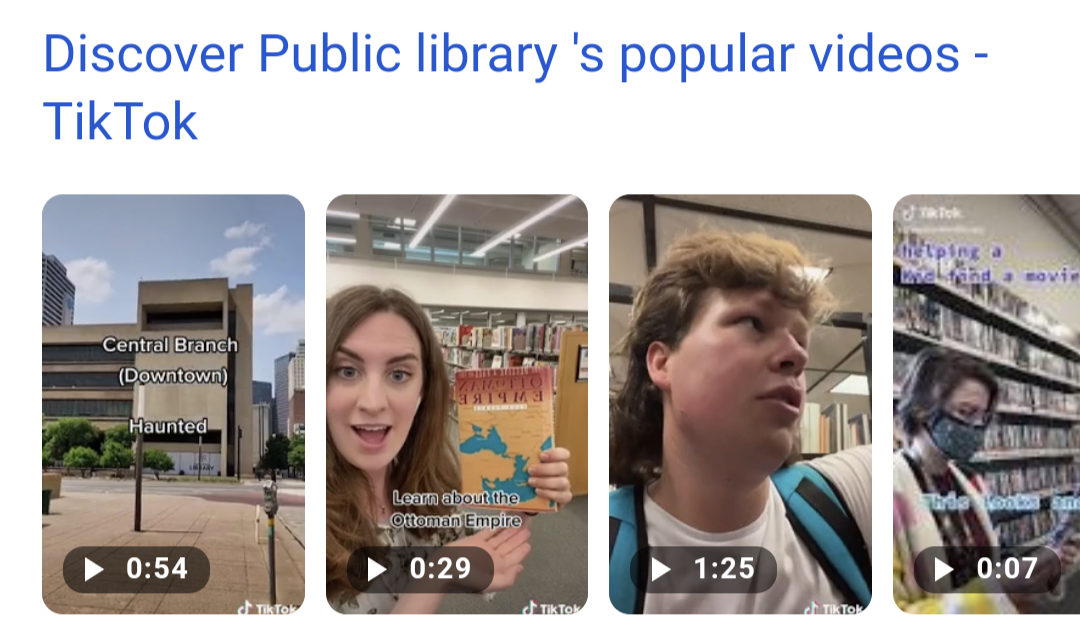TikTok, Misinformation, and Public Libraries
So many information sources and so many threats to information literacy! This is the first of what will likely be many posts on the challenges the public - and public libraries - face as they navigate available information resources. This one is focused on TikTok, a short-form video hosting service. It is one of the most popular - but also one of the least reliable - sources of information.
The app is as popular as scratch in a coop. In the United States, more than 100 million people use TikTok every month. And over the past two years, Americans over the age of 18 are estimated to have spent more than 1.4 BILLION hours on the app. But the over-18 crowd is nothing to teens, which make up 69 percent of the app’s users here in the US.
Libraries everywhere are hopping on the TikTok train!
The app’s popularity helps explain why so many public libraries have hopped on the TikTok train. A quick Google search turns up almost 44 million results for “TikTok public library.” They’re a mixed bag, ranging from librarians promoting programs and resources to others discussing the profession and still others bemoaning the current state of intellectual freedom and censorship. These last ones matter - in more ways than one.
One of the things it’s super-important to understand is that TikTok has become WAY more than a source for entertainment, inspiration, and inane challenges. For a growing number of people, it has also become the search engine and news/information source of choice. And, unfortunately, it’s not an insubstantial number.
As reported in The Guardian, “A quarter of US adults say they always use TikTok to get the news, with nearly half of US millennial and Gen Z adults – under-41s and under-25s, respectively – indicating the same, according to the analysis firm Forrester Research.”
The use of TikTok for news and information has come into sharper focus during the war in Ukraine. Its reach and grip on users have made it impossible for political leaders and policy-makers to ignore, as evidenced by President Biden’s Zoom briefing for 30 TikTok influencers regarding the conflict in March.
From an information perspective, there is plenty of room for concern. As much of the coverage of TikTok has noted, the platform is uniquely susceptible to misinformation. (Of course, misinformation is only one of the problems dogging TikTok. There’s also national security, data governance, privacy, its algorithm, etc., . . . but those are separate issues.)
While some feel that what they see on TikTok is “more real, more authentic” than on other social platforms, that is not always the case. Early in the Ukraine war, National Public Radio reported on the “surge” of misleading videos that appeared on the app. These included clips from video games, scenes from movies, and footage from past conflicts.
Abbie Richards, an independent researcher quoted in The Guardian, said, “We saw immediately from the start of the conflict that TikTok was structurally incompatible with the needs of the current moment regarding disinformation.”
In 2021, TikTok took steps to address misinformation in the app with its “#FactCheckYourFeed” campaign. But it’s hard to imagine how a hashtag program will actually help people “guard themselves against potential harms” or help them “to think critically.” How this is done in a universe of short snippets of information appearing at a rapid pace with little moderation/oversight is anyone’s guess.
A screen capture included in the Shorenstein report. The trees are so green in February.
Jennifer Nilsen, Kaylee Fagan, Emily Dreyfuss, and Joan Donovan of The Shorenstein Center on Media, Politics and Public Policy at the Harvard Kennedy School put a finer point on the problem in their report, TikTtok, The War On Ukraine, And 10 Features That Make The App Vulnerable To Misinformation.
Among the vulnerabilities cited by the team are:
TikTok’s suite of built-in video editing tools allows users to manipulate video and audio in a misleading way.
The fact that pseudonyms are popular on TikTok makes it harder to discern who a poster is, where they are, and whether their video content is original or real.
Memes, parodies, and role-playing videos are all common genres on the platform, and viewers who aren't familiar with this specific form of comedy could mistake them as real.
While TikTok pledges to label and remove misinformation, as well as take potential misinformation out of its recommendation algorithm, the application of this policy is inconsistent.
They conclude by observing that while “TikTok personalities have an opportunity to mitigate the spread of mis- and disinformation by posting timely, accurate, local knowledge (TALK), the incentives to do so are low compared to the massive rewards of posting manipulated media.”
These things should raise questions for a profession committed to providing accurate information. Is the mere participation on TikTok by public libraries an endorsement or validation of the app and its information practices? Are users who view a library’s videos at risk of being algorithmically shunted to less desirable content? Does a platform that exacerbates many of the things that are wrong with the current information environment deserve libraries’ seal of approval?
The answer needs to be no.
Some may argue that libraries, by their nature, should provide access to information in all its forms. But a platform like TikTok, which is fundamentally flawed from a misinformation and data perspective, doesn’t deserve that honor. Instead of encouraging information literacy, TikTok - by its very nature - erodes those fundamental skills. A library’s presence on TikTok presents the app as a valid source of information, and that simply isn’t the case.
Misinformation and disinformation are rampant. They are easy to stumble across, difficult to identify, and virtually impossible to stop. As Richards observed above, TikTok is “structurally incompatible” in this moment of misinformation. It is that structural incompatibility that is the problem, and libraries need to step away.


